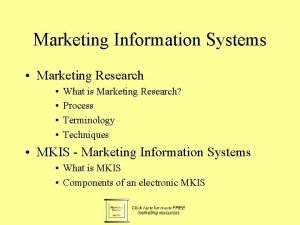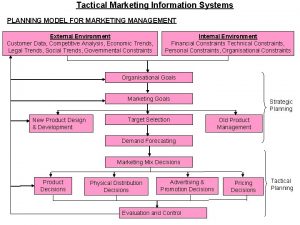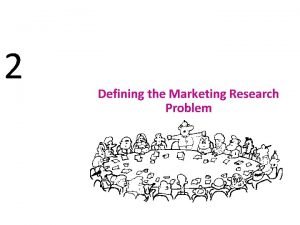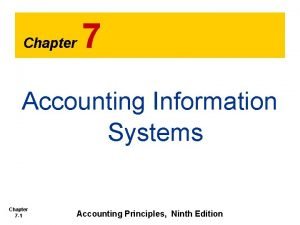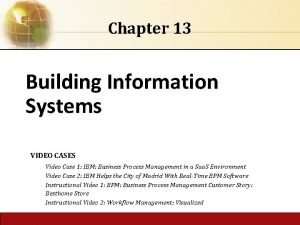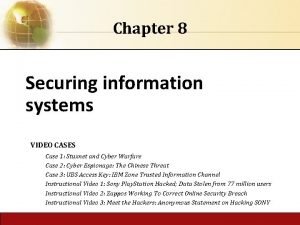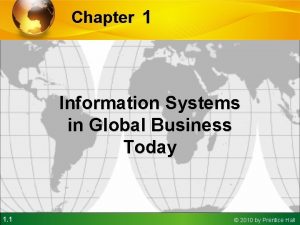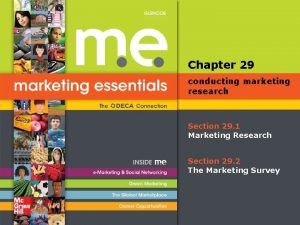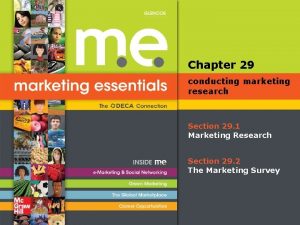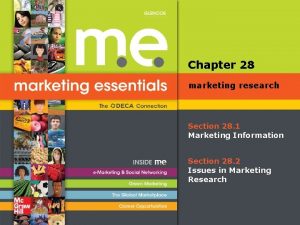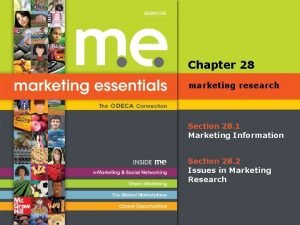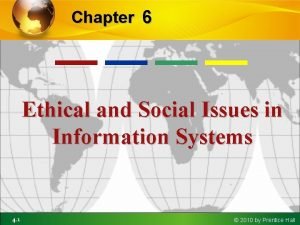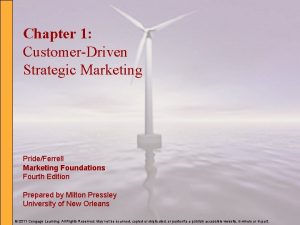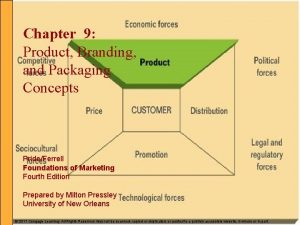Chapter 4 Marketing Research and Information Systems PrideFerrell







































- Slides: 39

Chapter 4: Marketing Research and Information Systems Pride/Ferrell Foundations of Marketing Fourth Edition Prepared by Milton Pressley University of New Orleans Copyright © Cengage Learning. All rights reserved.

Objectives • • • Define marketing research and understand its importance. Describe the basic steps in conducting marketing research. Explore the fundamental methods of gathering data for marketing research. Describe how tools such as databases, decision support systems, and the Internet facilitate marketing information systems and research. Identify key ethical and international considerations in marketing research. Copyright © Cengage Learning. All rights reserved.

Marketing Research • The systematic design, collection, interpretation, and reporting of information to help marketers solve specific marketing problems or take advantage of marketing opportunities. Importance of Marketing Research Irwin provides services to help companies better understand their customers’ needs Copyright © Cengage Learning. All rights reserved.

Discussion Question • Can you think of a situation in which you would introduce a new product to a market where marketing research would be inappropriate? Copyright © Cengage Learning. All rights reserved.

• • • The Benefits of Marketing Research Facilitates strategic planning Assess opportunities/threats Ascertain potential for success Determine feasibility Improves marketer’s ability to make decisions Copyright © Cengage Learning. All rights reserved.

The Marketing Research Process Copyright © Cengage Learning. All rights reserved.

Discussion Question • Which of the five steps of the marketing research process is the most important? Copyright © Cengage Learning. All rights reserved.

Locating and Defining Issues or Problems • Focusing on uncovering the nature and boundaries of a situation or question related to marketing strategy or implementation – Departures from normal or expected marketing results – Typical problems requiring research – Discover reasons for exceeding/not meeting goals – Evidence of possible or potential market opportunities Copyright © Cengage Learning. All rights reserved.

Defining the Problem • Nature/scope of situation • Clear definition of need • Determine precisely what research is to determine • How will research be used? Copyright © Cengage Learning. All rights reserved.

Designing the Research Project • Research Design – An overall plan for obtaining the information needed to address a research problem or issue • Hypothesis – An informed guess or assumption about a certain problem or set of circumstances – Accepted or rejected hypotheses act as conclusions for the research effort Copyright © Cengage Learning. All rights reserved.

Types of Research • Exploratory Research – Conducted to gather more information about a problem or to make a tentative hypothesis more specific – How are consumers car buying habits changing? • Conclusive Research – Designed to verify insights through objective procedures and to help marketers in making decisions – What % of consumers will consider an electric car purchase? • Descriptive Research – Conducted to clarify the characteristics of certain phenomena to solve a particular problem – How are consumers gathering information to assist in car buying? • Experimental Research – Research that allows marketers to make causal inferences about relationships Copyright © Cengage Learning. All rights reserved.

Differences Between Exploratory and Conclusive Research Copyright © Cengage Learning. All rights reserved.

Reliability and Validity • Reliability – A condition existing when a research technique produces almost identical results in repeated trials – also considered as ‘repeatability’ if results can be replicated • Validity – A condition existing when a research method measures what it is supposed to measure Copyright © Cengage Learning. All rights reserved.

Collecting Data • Primary data: • Is observed, recorded or collected directly from respondents • Is collected to address a specific problem that cannot be answered by secondary data alone Primary Data Collection M/A/R/C works with multinational companies to collect primary data to maintain strong brand equity Copyright © Cengage Learning. All rights reserved.

Collecting Data • Secondary data: • Is compiled both inside and outside the organization • Is for some purpose other than the current investigation Copyright © Cengage Learning. All rights reserved.

External Sources of Secondary Data Copyright © Cengage Learning. All rights reserved.

External Sources of Secondary Data Copyright © Cengage Learning. All rights reserved.

Web Exercise Census: Click on the @ symbol to access the U. S. Census State and County Quick Facts Web Site. Once there, explore some of the information available for one or more states. Copyright © Cengage Learning. All rights reserved.

Discussion Question • Can you name any of the top marketing research firms in the U. S. ? • Which marketing research firm do you think is the largest in terms of sales revenue? Click on the @ for the answers Copyright © Cengage Learning. All rights reserved.

Methods of Collecting Primary Data • Population - all the elements, units, or individuals of interest to researchers for a specific study • Sample - a limited number of units chosen to represent the characteristics of the population • Sampling - the process of selecting representative units from a total population Copyright © Cengage Learning. All rights reserved.

Probability Sampling • Probability sampling – sampling technique in which every element in the population being studied has a known chance of being selected for study • Random sampling – type of probability sampling in which all units in a population have an equal chance of appearing in a sample • Stratified sampling – type of probability sampling in which the population is divided into groups according to a common attribute; a random sample is then chosen within each group Copyright © Cengage Learning. All rights reserved.

Nonprobability Sampling • Nonprobability sampling – sampling technique in which there is no way to calculate the likelihood that a specific element of the population being studied will be chosen • Quota sampling – nonprobability sampling technique in which researchers divide the population into groups and then arbitrarily choose participants from each group Copyright © Cengage Learning. All rights reserved.

How Types of Sampling Align Sampling Probability Nonprobability Random Sampling Stratified Sampling Quota Copyright © Cengage Learning. All rights reserved.

Survey Methods • Mail Sample Mail Survey • Telephone Sample Phone Survey • Online Sample Online Survey • Personal Interview Collecting Data Through Surveys Infosurv assists clients in the development and execution of online surveys Copyright © Cengage Learning. All rights reserved.

Social Networking and Surveys • Social networking sites – can be used to gather useful information in understanding consumer decisions – provide a new way for marketers to conduct market research. Copyright © Cengage Learning. All rights reserved.

Comparing Four Basic Survey Methods Copyright © Cengage Learning. All rights reserved.

Forms of Personal Interviews • Focus-group • observation of group interaction when members are exposed to an idea or concept • In-home/Door-to-Door • takes place in respondents’ homes • Customer advisory boards • small groups of actual customers providing feedback on ideas, products, marketing strategies Kentucky Fried Chicken “Mom’s Matter” • Telephone depth • combines ability to probe with confidentiality Computer Assisted Telephone Interviewing (CATI) • Shopping-mall intercept • interviewing a % of persons walking through malls Copyright © Cengage Learning. All rights reserved.

Benefits of a Personal Interview • Rapport • More in-depth – Probes – Follow-up – Tests • Longer • Yield more information • Respondents can be carefully selected, reasons for nonresponse explored • Allow you greater flexibility Copyright © Cengage Learning. All rights reserved.

Questionnaire Construction Question Types • Open-Ended Question What is your general opinion about coffee shops? ________________________ • Dichotomous Question Have you ever purchased a coffee product? Yes _____ No _____ • Multiple-Choice Question What income group are you in? $0 -$19, 000 _____ $20, 000 -$59, 999 _____ $60, 000 -$99, 000 _____ more than $100, 000 _____ Copyright © Cengage Learning. All rights reserved.

Observation Methods • Direct contact with subject is avoided to reduce possible awareness of observation process. • Physical conditions, subject actions, and demographics are noted. • Observations may be combined with same subject interviews. • Data gathered may be influenced by observer bias. Copyright © Cengage Learning. All rights reserved.

Interpreting Research Findings • Statistical interpretation - focuses on what is typical or what deviates from the average Interpreting Research Companies like Market Strategies can help interpret the data collected from market research and offer insight into the areas investigated Copyright © Cengage Learning. All rights reserved.

Reporting Research Findings • Prepare a formal, written document • Clear, objective look • Point out deficiencies • Formal, written document • Determine level of detail • Summary/recommendations first Copyright © Cengage Learning. All rights reserved.

Using Technology to Improve Marketing Information Gathering and Analysis Using Technology Re Rez uses some of the most advanced marketing research technology to assist clients Copyright © Cengage Learning. All rights reserved.

Technology and Information Gathering and Analysis • Increasingly accessible • Customer relationship management enhanced • Permits internal research and quick information gathering • Access array of valuable information sources Copyright © Cengage Learning. All rights reserved.

Types of Technology Used • Marketing Information Systems (MIS) – framework for managing and structuring information gathered from internal and external sources • Databases – Single-source data provided by single marketing research firm • Marketing Decision Support Systems (MDSS) – customized computer software that aids marketing managers in decision making Copyright © Cengage Learning. All rights reserved.

The Importance of Ethical Marketing Research Copyright © Cengage Learning. All rights reserved.

International Issues in Marketing Research – Modification of data-gathering methods to account for regional differences – Use of two-pronged approach to international marketing research – Consider sociocultural, economic, political, legal, and technological forces Copyright © Cengage Learning. All rights reserved.

After Reviewing This Chapter You Should Be Able to: • • • Define marketing research and explain its importance. Describe the basic steps in conducting marketing research. Discuss the fundamental methods of gathering data for marketing research. Describe how tools such as databases, decision support systems, and the Internet facilitate marketing information systems and research. Identify key ethical and international considerations in marketing research. Copyright © Cengage Learning. All rights reserved.

Key Concepts • • • • • Marketing research Research design Hypothesis Exploratory research Conclusive research Descriptive research Experimental research Reliability Validity Primary data Secondary data Population Sample Sampling Probability sampling Random sampling Stratified sampling Nonprobability sampling Copyright © Cengage Learning. All rights reserved. • • • • Quota sampling Mail survey Telephone survey Online survey Personal interview survey In-home (door-to-door) interview Focus-group interview Customer advisory boards Telephone depth interview Shopping mall intercept interview Statistical interpretation Marketing information system (MIS) Database Single-source data Marketing decision support system (MDSS)
 Finer segmentation
Finer segmentation Marketing information systems and marketing research
Marketing information systems and marketing research Define marketing information management
Define marketing information management Marketing information systems and marketing research
Marketing information systems and marketing research Marketing information system kotler
Marketing information system kotler Marketing information systems and marketing research
Marketing information systems and marketing research Tactical market research
Tactical market research Marketing information management definition
Marketing information management definition Market research problem definition
Market research problem definition Chapter 4 ethical issues
Chapter 4 ethical issues 4 components of an information system
4 components of an information system Chapter 3 information systems organizations and strategy
Chapter 3 information systems organizations and strategy Functions of an information system
Functions of an information system Securing information systems
Securing information systems Chapter 8 securing information systems
Chapter 8 securing information systems Chapter 7 accounting information systems
Chapter 7 accounting information systems Chapter 7 accounting information systems
Chapter 7 accounting information systems Dfd chapter 13
Dfd chapter 13 Chapter 8 securing information systems
Chapter 8 securing information systems White-collar workers คือ
White-collar workers คือ Fundamental of information system
Fundamental of information system Global challenges in information system
Global challenges in information system Chapter 8 securing information systems
Chapter 8 securing information systems Information systems in global business today
Information systems in global business today Introduction management information system
Introduction management information system Chapter 8 securing information systems
Chapter 8 securing information systems Chapter 7 accounting information systems
Chapter 7 accounting information systems Chapter 1 information systems in global business today
Chapter 1 information systems in global business today Chapter 29 conducting marketing research
Chapter 29 conducting marketing research Chapter 29 conducting marketing research answers
Chapter 29 conducting marketing research answers Chapter 28 marketing research
Chapter 28 marketing research Chapter 28 marketing research
Chapter 28 marketing research Marketing research chapter 1
Marketing research chapter 1 The marketing research process follows five steps
The marketing research process follows five steps Chapter 28 marketing research
Chapter 28 marketing research Decision support systems and intelligent systems
Decision support systems and intelligent systems Managing and using information systems
Managing and using information systems Moral dimensions of information systems
Moral dimensions of information systems Information systems and communication technologies quiz
Information systems and communication technologies quiz Ethical and social issues in information systems doc
Ethical and social issues in information systems doc

